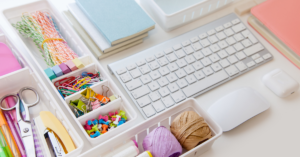Recently, we had Kathryn Snearly from Do It On A Dime on our podcast. We discussed Swedish Death Cleaning and breaking the cycle of generational clutter. It was a great conversation for sentimental items and hand-me-downs, but what about everyday clutter? The clutter that we stuff in a closet or tuck into a drawer. The clutter that consumes us (and seems to multiply the more people you live with.) How do we get to a place where we feel we aren’t constantly organizing? How do we get rid of clutter?
We knew Kathryn had answers, so we called her up and asked for her best tips:
The First Step To Get Rid of Clutter
The first thing you should know is that there isn’t a single person that does not feel overwhelmed by some spot in their house. If you’re a busy person, it’s hard to carve out time or get motivated for a project you probably don’t have time for. Or maybe you do have time, but you disassociate because it feels like too much. This is where you try a new technique.
Tip #1: Use Pomodoro’s Technique
Pomodoro’s Technique is a time management system that works with you instead of against you. The idea is that you set a timer and focus on a single task, then you force yourself to take a break before resuming. Use a modification of this by picking one spot to organize and setting a timer for 15 minutes. Select a high access area that will give you an incentive to keep going. This could be a junk drawer, kitchen counter, or high traffic closet/entryway. Once the 15 minutes is complete, take a break and set the timer again if needed. This can kick start motivation for larger projects.
Tip #2: Keep 20% Freespace
It’s easy to overstuff a space when you’re organizing (even our expert Kathryn used to do this.) You get containers or spaces that just fit everything you want in them. The problem with this is that it’s that much harder to keep those spaces tidy and uniform. One item out of place is like a domino effect. Keep 20% free space of “buffer room” in whatever space you’re organizing. This means 20% free space in containers, drawers, shelves, and bins.
Once you have that buffer in place, your container can act as a signal to declutter. Once it loses its 20% free space you need to clean it out.
Tip #3: Focus On What You Use
It can be stressful to clean out a space and focus on what you don’t need. Instead, focus on what you love and what you use. Closets are a great spot for this exercise. Pull out what you love and wear all the time. Once you have those items, look at what is left. Do you need those items? If you’re not ready to give them away, can you store them somewhere else in the event you need them? (Then if you don’t miss them after a couple months, you can give them away later.) Find that if you focus on what you love first, you can make decisions faster.
Tip #4 Make Sure You Can See Everything
It’s so easy to forget about everyday items when they are tucked away in a bin. Clear storage and open bins are great for making sure items can be seen and they are easy to pull in and out. Make sure as you are organizing that you have one step in and one step out for each item. If you have multiple steps to getting an item or putting them away, it makes it harder to keep clean. Another tip is to make sure you can visually see your items as well. If you are working with a dark closet or cabinet, inexpensive puck lights can help.
Here are some recommended products that can help:
Tip #5: Always Be DeCluttering
Have a basket in your bedroom closet, laundry room, or playroom that is your decluttering bin. If you notice you don’t need something any more, put it in the bin! Once it gets full you take the items to be donated. The bin can be as simple as an old laundry basket. Also, don’t be afraid to declutter items like toys by yourself rather than involving your kids. You can always put them in a “halfway home” to let some time pass and make sure they are ok to give away before you do.
Your Best Is Enough
If you live with other people, make sure you explain new organization systems or decluttering to them. This helps them be active members in the process of putting things away. You should also give yourself (and those around you) a little grace. If you organize your fridge, for example, and 2 weeks later it looks crazy again – that’s normal! For every time a day you touch a space, that is how many times a quarter you should be organizing it. So if you touch your fridge on average 9 times per day, then at the end of every week you will probably need to do something with it.
Even the prettiest pictures you see on Pinterest don’t look like that all the time. As long as you’re doing your best, it’s good enough. What tips do you to get rid of clutter that we missed? Let us know!
Note: Some of the items in this blog include Amazon Affiliate and other links which earn a small commission.









